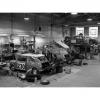Engine Compression Test Results
#1

Posted 15 March 2014 - 05:47 PM
#2

Posted 15 March 2014 - 05:50 PM
Thats good for 100k miles!
#3

Posted 15 March 2014 - 06:14 PM
#4

Posted 16 March 2014 - 08:54 AM
I've just written this all out and noticed you have mentioned head work, sorry if this seems patronising in any way, it isn't intended to, I will leave it here as it took so long to write out.
In theory I see no reason as to why you couldn't use this motor as a turbo donor if everything is in order. You have established that you have good compression and providing the compression ratio is lowered in a suitable manner it could be quite successful.
Edit
Hello Sam, unfortunately it does not work like that.
What you have gained by this test is that you have good compression in the fact that your valves, head gasket, rings and piston are forming a good solid seal for your combustion process, unfortunately you need to know a bit more regards compression ratios before you can start looking at effectively using a turbo.
What you are hoping to achieve with a turbo is a lower compression ratio, when you run an engine naturally aspirated you want a huger compression ratio.
Here is a pretty much spot on explanation by another forum member, all credit of course goes to him, no point me writing it out when he has it all here already.
Once you have worked out your compression ratio or C/R you can then look at turbos.C.R. CALCULATIONS & MEASUREMENTS
1. Measure the average distance from piston top to block deck level with the pistons at TDC. Take the average for all 4 pistons.
2. Calculate the capacity of this volume (Call it A)For 0.010 piston top to block deck this capacity will be: Standard bore at 1275 cc = 0.99 cc At +0.020 overbore = 1.01 cc At +0.030 overbore = 1.02 cc At +0.040" overbore = 1.025 cc At +0.060 overbore = 1.04 cc
3. Measure the volume of the dish in the top of the piston using the 5-cc syringe with paraffin, meths, or even clean water. With Hepolite 20250, 20251 & 20253 pistons this is 8.3 cc.Call this B
4. Set the head up to be absolutely level using a spirit level. Measure the combustion chamber volume in the head using the syringe and paraffin, meths, or clean water. Do this for a couple of chambers and take the average. Call this C
5. There is a volume in the head gasket area and well make an assumption here that with the average gasket, say a BK450 or AF460, its 4 cc. Call this D
6. There is the ring land volume. Thats the volume down the side of the piston to the top of the top ring. Allow 0.75 cc for this. Call it E.
7. Now divide the actual swept volume of your engine by 4 to get the swept volume per cylinder. Call this the swept volume SVFor a standard 1275 cc = 318.75 ccAt +0.020 overbore, i.e. 1293 cc = 323.25 ccAt +0.040 i.e. 1310 cc = 327.5 ccAt +0.060 i.e. 1330 cc = 332.5 cc
8. Add all the unswept volumes together i.e. A+B+C+D+E.Call this the Total Unswept Volume UV
9. The Comp Ratio (CR) = (SV+UV) divided by UVSo, if you have a standard bore 1275 cc engine with the SV = 318,75And if the total of the other volumes, the total unswept vol. UV =, say, 36 cc,The CR = (318.75 + 36) divided by 36 = 354.75 / 36 = 9.85 to 1
However, if that is not the CR you want, you have to work backwards to calculate what the combustion chamber volume in the head should be.Say you have the figures we just used, but you want the CR to be 10.4 to 1.
The formula to work out what the UV should be is:
SV divided by (CR-1) = UV
So, in the case we are using: UV = 318.75/(10.4 1) = 318.75 divided by 9.4. = 33.9 cc Add A+B+D+E, as established earlier and subtract this from the new figure for UV, in this case subtract it from 33.9. The resulting figure is the actual volume you need each combustion chamber to be.Using the syringe again, after setting the head up to be absolutely level, put EXACTLY this amount of fluid (paraffin, meths or clean water) into a combustion chamber.The distance from the head face to the surface of the fluid is the amount to be skimmed from the head. To measure this put a steel ruler across the head above the chamber and measure down to the fluid surface with a digital vernier, subtracting the thickness of the ruler afterwards. In practice, this is the most difficult dimension to measure as the fluid has a meniscus which sort-of reaches up to the bottom of the vernier calliper. You have to make a judgement on this, but dont be put off, it is not that hard. Once the head is skimmed as necessary you just fit it and your CR is correct. Remember if you are increasing the CR you will need to check and adjust the timing.
My initial thoughts would be if it is a standard n/a 998 you will need to lower the compression. This can be done in numerous ways, head work, dished pistons, decompression plates, years ago when we were much younger with old ford turbos we used to stack headgaskets, I seem to remember a lad in a mk1 fiesta who stacked 3/4!
Hope that's of some help, Tomm
Edited by tomm, 16 March 2014 - 09:03 AM.
#5

Posted 17 March 2014 - 08:27 AM
1 user(s) are reading this topic
0 members, 1 guests, 0 anonymous users















